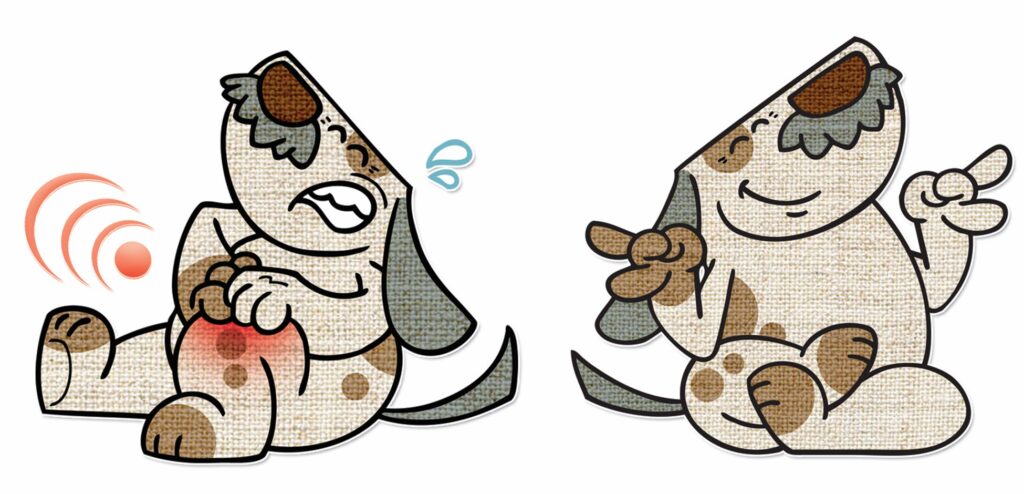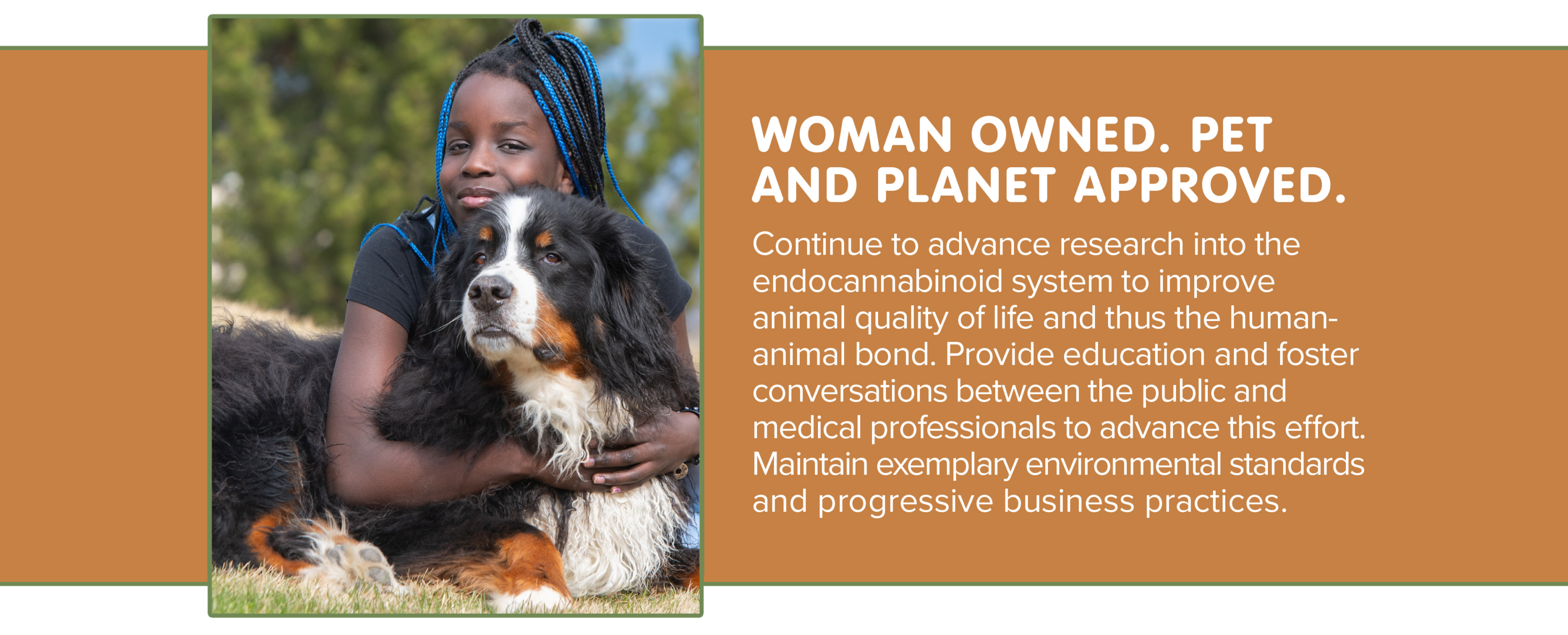How Pet CBD Works in Joints

CBD for joint health is all the rage right now, and for good reason. CBD is a potent antioxidant and one of the primary compounds the endocannabinoid system (ECS) – your pet’s cannabis receptor system – uses to reduce stress within the body. Within joint tissues, that stress often shows itself in specific ways leading to discomfort, reduced activity and stiffer gait when your pet is active. Thankfully, that same stress is kicking out chemicals to draw in CBD which helps soothe upset cells. Today, we’re going to explain that process to you so you have a better understanding of how CBD works in joints.
The ECS is the bodily receptor system that CBD primarily interacts with. It’s integral to normal development in utero, during puppy and kittenhood, into adulthood then senior and geriatric years. ECS receptors are found in nearly every type of cell within the body with higher concentration of receptors found within distressed tissues. Lastly and most importantly, the ECS has only one function within the body: listen to and correct cellular stress.

ECS Basics
There are a few main points we need to understand for the purposes of joint health and CBD administration. The ECS is made up of receptors, compounds like CBD and the pathways in between them. Receptors work by shuttling compounds into and out of cells, causing a cascade of events leading to soothing chemical release for the nearby cells and tissues.
While receptors are pretty flexible, they have their limit and prefer certain ratios of compounds for different tasks. Compounds like CBD and THC are especially sensitive to ratios but other less known compounds like CBG, CBN & CBC are also in the mix.
The pathways that alert and carry CBD to signaling receptors can be moved according to what the body needs, and often intertwine with other receptor systems for added benefit. The interconnectedness of ECS pathways with other systems helps it address multiple areas of stress at once, like joint discomfort and anxiousness. The ECS functions the same in joint tissues as it does in other bodily systems like gastrointestinal & urinary tracts and cardiovascular & neurological systems. For a more detailed explanation of the ECS, see our blog about CBD works in the neurological system.
Normal Adult Joint Anatomy
In order to understand how the ECS assists with joint flexibility we need to understand what a normal joint looks like. A normal adult joint comes into full development at about 2 yr of age in the majority of dogs and cats. Joints are made of more than just bones. They also need cartilage, joint fluid, ligaments, tendons, and the connective and muscular tissues surrounding them. All of these structures need to remain in top shape for optimal joint health.
Ligaments in the adult joint are fairly stiff but easily flex with movement of the limb; their fibers are fairly short and are supposed to only flex so far, providing stability to the joint. Tendons are longer, bending just enough during movement while still remaining somewhat stiff, helping to hold muscular attachments steady as large muscle groups do the heavy lifting. Connective tissues like the joint capsule help hold lubricating and soothing joint fluid, bathing the innermost cushiony cartilage lining bone ends in nourishing compounds.
All of these tissues have ECS receptors as part of their normal development and ongoing function and help your pet play for hours on end without discomfort.

Normal Senior Joint Anatomy
Normal daily activities place different kinds of stress on all aspects of the joint, and those stresses have a cumulative effect over time. Twisting motions of chasing agile prey (toys) test the limits of ligament flexibility, and jumping onto / off of surfaces places significant impact on bones, cartilage and joint fluid while stretching muscles and tendons to their limits. This combined with normal reduction in joint fluid, thinning of cartilage and shortening and increased stiffness of ligaments and tendons, takes its toll on how the overall structure functions.
The joint becomes more stiff. Muscles and tendons are no longer able to smoothly flex and extend the joint. Reduced range of motion is common which can cause changes in your pet’s gait.

How the ECS & CBD React to Joint Stress
In the normal adult joint, the ECS is primarily associated with the maintenance of things – keeping normal daily cellular stress to a minimum. Every time your dog or cat makes that amazing leap to get their favorite toy, the impact of landing creates microdamage to one or more of the tissues found within joints. This is normal and healthy as many of those damaged areas occur where cells nearing their life are located. The ECS and other receptor systems go to work, helping to direct which cells need calming or protecting from white blood cells clearing out damaged cells. Once the area is back to top function, the ECS returns to monitor mode and awaits the next stress signal. This process occurs rapidly and helps ensure the joint bends smoothly, tendons and muscles flow easily and ligaments remain supportive – all for a normal gait that allows your adult pet to continue making those astounding leaps.
In the normal senior joint, the ECS is both on hyper alert and a little over-taxed and unable to keep up. The problem lies in the ongoing nature of the aging process — nothing the ECS does will stop that process. But it can and does continue to address all the normal micro damages that occur within the joint. In this respect, it’s hyper alert, always listening to the stress signals coming from ligaments that are stiff, cartilage that’s thin and bones that have less space to move in due to less joint fluid. But it can only manufacture so much natural CBD, so it gets tired and goes into a maintenance level that’s not quite enough for the older joint.
When CBD is added to the mix in the form of supplementation, the ECS realizes it has more compounds to do its job. It makes more receptors and directs pathways to the older joint and its stressed tissues. If we keep the ECS balanced with proper ratios of CBD and THC, plus offer additional compounds like CBG, CBN & CBC in small amounts, the ECS can keep up with the older joint’s needs.
The chemicals released from receptor cells are now soothing rather than upsetting and the joint becomes more flexible, the gait smoother, and the pet more comfortable.

Canna Companion Joint Support Capsules
Our veterinarians understand joint health and the ECS and developed the Joint Support capsules specifically for cat and dog health.
They offer a unique blend of organic hemp-sourced ingredients that provide optimum CBD:THC for joints and include a multitude of other compounds for a full entourage effect that will have your pet asking for longer walks in no time! Our CBD capsule formulation supports normal joint functions with:
- Balanced ratios of CBD and THC (CBD:THC 3:1-4:1)
- Different types of CBD (CBDA:CBD 1:1)
- Combinations of other compounds (low levels of CBN & medium levels of CBG and CBC) &
- Specific terpene profiles rich in caryophyllene and pinene.



